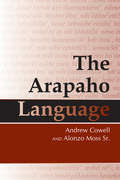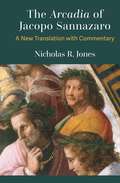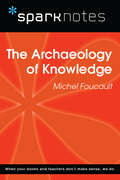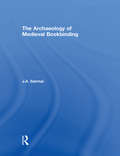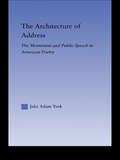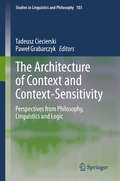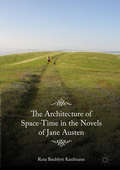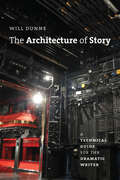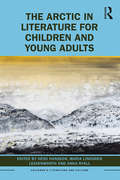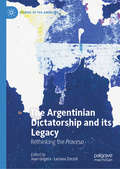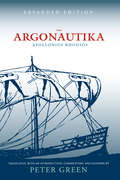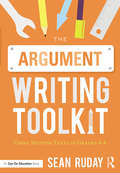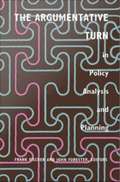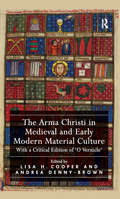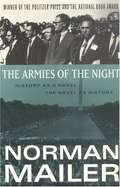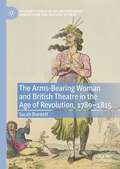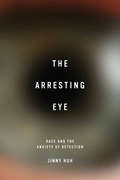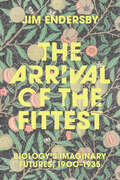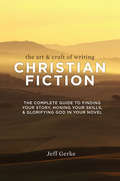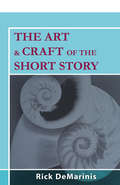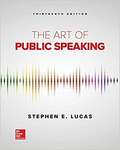- Table View
- List View
The Arapaho Language
by Alonzo Moss Sr. Andrew CowellThe Arapaho Language is the definitive reference grammar of an endangered Algonquian language. Arapaho differs strikingly from other Algonquian languages, making it particularly relevant to the study of historical linguistics and the evolution of grammar. Andrew Cowell and Alonzo Moss Sr. document Arapaho's interesting features, including a pitch-based accent system with no exact Algonquian parallels, radical innovations in the verb system, and complex contrasts between affirmative and non-affirmative statements. Cowell and Moss detail strategies used by speakers of this highly polysynthetic language to form complex words and illustrate how word formation interacts with information structure. They discuss word order and discourse-level features, treat the special features of formal discourse style and traditional narratives, and list gender-specific particles, which are widely used in conversation. Appendices include full sets of inflections for a variety of verbs. Arapaho is spoken primarily in Wyoming, with a few speakers in Oklahoma. The corpus used in The Arapaho Language spans more than a century of documentation, including multiple speakers from Wyoming and Oklahoma, with emphasis on recent recordings from Wyoming. The book cites approximately 2,000 language examples drawn largely from natural discourse - either recorded spoken language or texts written by native speakers. With The Arapaho Language, Cowell and Moss have produced a comprehensive document of a language that, in its departures from its nearest linguistic neighbors, sheds light on the evolution of grammar.
The Arapaho Language: Language And Power Among The Northern Arapaho
by Andrew Cowell Alonzo Moss, Sr.The Arapaho Language is the definitive reference grammar of an endangered Algonquian language. Arapaho differs strikingly from other Algonquian languages, making it particularly relevant to the study of historical linguistics and the evolution of grammar. Andrew Cowell and Alonzo Moss Sr. document Arapaho's interesting features, including a pitch-based accent system with no exact Algonquian parallels, radical innovations in the verb system, and complex contrasts between affirmative and non-affirmative statements. Cowell and Moss detail strategies used by speakers of this highly polysynthetic language to form complex words and illustrate how word formation interacts with information structure. They discuss word order and discourse-level features, treat the special features of formal discourse style and traditional narratives, and list gender-specific particles, which are widely used in conversation. Appendices include full sets of inflections for a variety of verbs. Arapaho is spoken primarily in Wyoming, with a few speakers in Oklahoma. The corpus used in The Arapaho Language spans more than a century of documentation, including multiple speakers from Wyoming and Oklahoma, with emphasis on recent recordings from Wyoming. The book cites approximately 2,000 language examples drawn largely from natural discourse - either recorded spoken language or texts written by native speakers. With The Arapaho Language, Cowell and Moss have produced a comprehensive document of a language that, in its departures from its nearest linguistic neighbors, sheds light on the evolution of grammar.
The Arcadia of Jacopo Sannazaro: A New Translation with Commentary
by Nicholas R. JonesFive hundred years ago, working from hints in classical Greek and Latin poets, the young author Jacopo Sannazaro crafted the book called Arcadia, a narrative in richly descriptive Italian prose interwoven with elegant and passionate poems. A young man—transparently a stand-in for the author—leaves his home in Naples to join a community of shepherds in the remote Greek region of Arcadia. Yet he finds that this seemingly idyllic land is as fraught as the homeland he fled. Like the author’s humanist community in Naples, ravaged in the fifteenth century by invasion and regime change, the eloquent shepherd-poets of Arcadia are driven to distraction and depression by the frustrations of desire and the social unrest that threatens their pastoral lives. Amidst all that, they tell each other their personal histories and share their sorrows in song. Sannazaro’s Arcadia is widely recognized as a foundational text of pastoral poetry, humanism, and Italian literature. But the book itself has been largely inaccessible to English-language students and readers. This new translation uses contemporary American English to convey Arcadia’s youthful vigor, narrative energy, and poetic inventiveness. The extensive introduction and commentaries place Arcadia in the context of late fifteenth-century humanist thought and writing, as well as the complicated crisis of Naples in the years just before 1500. This translation is designed to facilitate the re-entry of Arcadia into scholarly discourse and general readership while outlining its lasting cultural influence on poetry, drama, art and music.
The Archaeology of Knowledge (SparkNotes Philosophy Guide)
by SparkNotesThe Archaeology of Knowledge (SparkNotes Philosophy Guide) Making the reading experience fun! SparkNotes Philosophy Guides are one-stop guides to the great works of philosophy–masterpieces that stand at the foundations of Western thought. Inside each Philosophy Guide you&’ll find insightful overviews of great philosophical works of the Western world.
The Archaeology of Medieval Bookbinding
by J.A. SzirmaiIn the past, studies of the history of bookbinding were mainly concerned with the exterior decoration. This book focuses attention primarily on the physical aspects of the binding and its construction principles. It is an expanded version of a series of lectures delivered by the author while Visiting Professor at the University of Amsterdam in 1987, supplemented with the results of ten years of intensive research in major libraries on the Continent, the United Kingdom and the USA. It surveys the evolution of binding structures from the introduction of the codex two thousand years ago to the close of the Middle Ages. Part I reviews the scanty physical evidence from the Mediterranean heritage, the early Coptic, Islamic and Ethiopian binding structures and their interrelation with those of the Byzantine realm. Part II is devoted to a detailed analysis of Western binding techniques, distinguishing the carolingian, romanesque and gothic wooden-board bindings as the main typological entities; their structure and function is compared with those of contemporary limp bindings. The book is illustrated with over 200 drawings and photographs and contains a comprehensive bibliography.
The Architecture and Archaeology of Modern Logic: Studies Dedicated to Göran Sundholm (Logic, Epistemology, and the Unity of Science #61)
by Ansten KlevThis book honors the original and influential work by Göran Sundholm in the fields of the philosophy and history of logic and mathematics. Borne from two conferences held in Paris and Leiden on the occasion of Göran Sundholm’s retirement in 2019, the contributions collected in this volume represent work from leading logicians and philosophers. Reflecting Sundholm’s contributions to the history and philosophy of logic, this book is divided into two parts: the architecture and archaeology of logic.The essays collected in the ‘architecture’ section cover primarily the systematic approach to basic logical concepts taken by Sundholm, including type theory, epistemic assumptions, and notions of consequence. The ‘archaeology’ section includes contributions focused on Sundholm’s contributions to the history of philosophy and logic. Enclosing these two sections are, on the one end, autobiographical remarks of Sundholm's and, on the other, a paper on cooking and philosophy, reflectinganother of Sundholm's passions in life. This book is of interest to logicians, philosophers, mathematicians, and computer scientists.
The Architecture of Address: The Monument and Public Speech in American Poetry (Literary Criticism and Cultural Theory)
by Jake Adam YorkThe Architecture of Address traces the evolution of an American species of lyric capable of public pronouncement without polemic. Beginning with Whitman, Jake Adam York seeks to describe a kind of poem wherein the most ambitious poets--including Hart Crane and Robert Lowell--occupy and reconstruct important public spaces. This study argues that American poets become civic actors when their poems imagine and reconstruct the conceptual architecture of the monument.
The Architecture of Concepts: The Historical Formation of Human Rights
by Peter de BollaThe Architecture of Concepts proposes a radically new way of understanding the history of ideas. Taking as its example human rights, it develops a distinctive kind of conceptual analysis that enables us to see with precision how the concept of human rights was formed in the eighteenth century.The first chapter outlines an innovative account of concepts as cultural entities. The second develops an original methodology for recovering the historical formation of the concept of human rights based on data extracted from digital archives. This enables us to track the construction of conceptual architectures over time.Having established the architecture of the concept of human rights, the book then examines two key moments in its historical formation: the First Continental Congress in 1775 and the publication of Tom Paine’s Rights of Man in 1792. Arguing that we have yet to fully understand or appreciate the consequences of the eighteenth-century invention of the concept “rights of man,” the final chapter addresses our problematic contemporary attempts to leverage human rights as the most efficacious way of achieving universal equality.
The Architecture of Context and Context-Sensitivity: Perspectives from Philosophy, Linguistics and Logic (Studies in Linguistics and Philosophy #103)
by Paweł Grabarczyk Tadeusz CiecierskiThis volume addresses foundational issues of context-dependence and indexicality, which are at the center of the current debate within the philosophy of language. Topics include the scope of context-dependency, the nature of content and the character of input data of cognitive processes relevant for the interpretation of utterances. There's also coverage of the role of beliefs and intentions as contextual factors, as well as the validity of arguments in context-sensitive languages.The contributions consider foundational issues regarding context-sensitivity from three different, yet related, perspectives on the phenomenon of context-dependence: representational, structural, and functional. The contributors not only address the representational, structural and/or functional problems separately but also study their mutual connections, thus furthering the debate and bringing competing approaches closer to unification and consensus. This text appeals to students and researchers within the field.This is a very useful collection of essays devoted to the roles of context in the study of language. Its essays provide a useful overview of the current debates on this topic, and they put forth novel contributions that will undoubtedly be of relevance for the development of all areas in philosophy and linguistics interested in the notion of context. Stefano Predelli Department of Philosophy, University of Nottingham, Nottingham, UK
The Architecture of Space-Time in the Novels of Jane Austen
by Ruta Baublyté KaufmannThis book argues that there are recurrent spatiotemporal patterns and structures in six Jane Austen novels which constitute a source of enduring, if unconscious, pleasure. More precisely, the book contends that there are overlapping natural and cultural cycles which co-exist in a constantly transmuting space-time and which are counterpointed with the linearity of pivotal events that drive the plot forwards. This work examines the psychological relations to these space-time patterns of the characters, principally the heroines, focusing on the transformations of their emotional states which prompt linear leaps.
The Architecture of Story: A Technical Guide for the Dramatic Writer (Chicago Guides to Writing, Editing, and Publishing)
by Will DunneWhile successful plays tend to share certain storytelling elements, there is no single blueprint for how a play should be constructed. Instead, seasoned playwrights know how to select the right elements for their needs and organize them in a structure that best supports their particular story. Through his workshops and book The Dramatic Writer's Companion, Will Dunne has helped thousands of writers develop successful scripts. Now, in The Architecture of Story, he helps writers master the building blocks of dramatic storytelling by analyzing a trio of award-winning contemporary American plays: Doubt: A Parable by John Patrick Shanley, Topdog/Underdog by Suzan-Lori Parks, and The Clean House by Sarah Ruhl. Dismantling the stories and examining key components from a technical perspective enables writers to approach their own work with an informed understanding of dramatic architecture. Each self-contained chapter focuses on one storytelling component, ranging from "Title" and "Main Event" to "Emotional Environment" and "Crisis Decision." Dunne explores each component in detail, demonstrating how it has been successfully handled in each play and comparing and contrasting techniques. The chapters conclude with questions to help writers evaluate and improve their own scripts. The result is a nonlinear reference guide that lets writers work at their own pace and choose the topics that interest them as they develop new scripts. This flexible, interactive structure is designed to meet the needs of writers at all stages of writing and at all levels of experience.
The Arctic in Literature for Children and Young Adults (Children's Literature and Culture)
by Heidi Hansson Maria Lindgren Leavenworth Anka RyallAs a setting for juvenile literature, the Arctic has traditionally been a space for adventure, the exotic and the fantastic. More recent works have used the Arctic setting to explore a dystopian future, often related to climate change. The aim of the present volume is to examine themes in Arctic juvenile fiction from the early nineteenth century until today. The deceptive image of the Arctic as geographically uniform seems to promise a cultural coherence, but the collection illustrates the diversity of Arctic literature by critically discussing and comparing works written by visitors and settlers as well as by indigenous peoples. The chapters combine macro- and micro-perspectives to interrogate and illuminate the role of Arctic literature for young readers in creating, maintaining and increasingly challenging Arctic myths and motifs.
The Argentinian Dictatorship and its Legacy: Rethinking the Proceso (Studies of the Americas)
by Juan Grigera Luciana ZorzoliThis edited volume provides a comprehensive overview of the renewal of academic engagement in the Argentinian dictatorship in the context of the post-2001 crisis. Significant social and judicial changes and the opening of archives have led to major revisions of the research dedicated to this period. As such, the contributors offer a unique presentation to an English-speaking audience, mapping and critiquing these developments and widening the recent debates in Argentina about the legacy of the dictatorship in this long-term perspective.
The Argonautika
by Peter Green Apollonios RhodiosThe Argonautika, the only surviving epic of the Hellenistic era, is a retelling of the tale of Jason and the Golden Fleece, probably the oldest extant Greek myth. Peter Green's lively, readable verse translation captures the swift narrative movement of Apollonios's epic Greek. This expanded paperback edition contains Green's incisive commentary, introduction, and glossary. Alternate spelling: Argonautica, Apollonius Rhodius
The Argonauts
by Maggie NelsonAn intrepid voyage out to the frontiers of the latest thinking about love, language, and family Maggie Nelson's The Argonauts is a genre-bending memoir, a work of "autotheory" offering fresh, fierce, and timely thinking about desire, identity, and the limitations and possibilities of love and language. It binds an account of Nelson's relationship with her partner and a journey to and through a pregnancy to a rigorous exploration of sexuality, gender, and "family." An insistence on radical individual freedom and the value of caretaking becomes the rallying cry for this thoughtful, unabashed, uncompromising book.
The Argument Writing Toolkit: Using Mentor Texts in Grades 6-8
by Sean RudayIn order for students to write effective arguments, they need to read good arguments. In this practical book, you’ll find out how to use mentor texts to make writing instruction more meaningful, authentic, and successful. Author Sean Ruday demonstrates how you can teach middle school students to analyze the qualities of effective arguments and then help them think of those qualities as tools to improve their own writing. You’ll learn how to: Introduce high-interest topics to students to get them interested and engaged in argument writing. Teach students to look at multiple sides of an issue and critically evaluate evidence to construct informed, defensible arguments. Make argument writing an interactive, student-driven exercise in which students pursue their own writing projects. Use mentor texts to help students learn the core concepts of argument writing and apply those skills across the curriculum. The book is filled with examples and templates you can bring back to the classroom immediately, as well as an annotated bibliography which links the concepts in this book to the corresponding Common Core State Standards. Blank templates are also available as printable eResources on our website (http://www.routledge.com/9781138924390).
The Argumentative Turn in Policy Analysis and Planning
by John Forester Frank FischerPublic policy is made of language. Whether in written or oral form, argument is central to all parts of the policy process. As simple as this insight appears, its implications for policy analysis and planning are profound. Drawing from recent work on language and argumentation and referring to such theorists as Wittgenstein, Habermas, Toulmin, and Foucault, these essays explore the interplay of language, action, and power in both the practice and the theory of policy-making. The contributors, scholars of international renown who range across the theoretical spectrum, emphasize the political nature of the policy planner's work and stress the role of persuasive arguments in practical decision making. Recognizing the rhetorical, communicative character of policy and planning deliberations, they show that policy arguments are necessarily selective, both shaping and being shaped by relations of power. These essays reveal the practices of policy analysts and planners in powerful new ways--as matters of practical argumentation in complex, highly political environments. They also make an important contribution to contemporary debates over postempiricism in the social and policy sciences. Contributors. John S. Dryzek, William N. Dunn, Frank Fischer, John Forester, Maarten Hajer, Patsy Healey, Robert Hoppe, Bruce Jennings, Thomas J. Kaplan, Duncan MacRae, Jr. , Martin Rein, Donald Schon, J. A. Throgmorton
The Arma Christi in Medieval and Early Modern Material Culture: With a Critical Edition of 'O Vernicle'
by Lisa H. Cooper Andrea Denny-BrownThe Arma Christi, the cluster of objects associated with Christ’s Passion, was one of the most familiar iconographic devices of European medieval and early modern culture. From the weapons used to torment and sacrifice the body of Christ sprang a reliquary tradition that produced active and contemplative devotional practices, complex literary narratives, intense lyric poems, striking visual images, and innovative architectural ornament. This collection displays the fascinating range of intellectual possibilities generated by representations of these medieval ’objects,’ and through the interdisciplinary collaboration of its contributors produces a fresh view of the multiple intersections of the spiritual and the material in the Middle Ages and Renaissance. It also includes a new and authoritative critical edition of the Middle English Arma Christi poem known as ’O Vernicle’ that takes account of all twenty surviving manuscripts. The book opens with a substantial introduction that surveys previous scholarship and situates the Arma in their historical and aesthetic contexts. The ten essays that follow explore representative examples of the instruments of the Passion across a broad swath of history, from some of their earliest formulations in late antiquity to their reformulations in early modern Europe. Together, they offer the first large-scale attempt to understand the arma Christi as a unique cultural phenomenon of its own, one that resonated across centuries in multiple languages, genres, and media. The collection directs particular attention to this array of implements as an example of the potency afforded material objects in medieval and early modern culture, from the glittering nails of the Old English poem Elene to the coins of the Middle English poem ’Sir Penny,’ from garments and dice on Irish tomb sculptures to lanterns and ladders in Hieronymus Bosch’s panel painting of St. Christopher, and from the altar of the Sistine Chapel to the printed prayer books of the Reformation.
The Armies of the Night: History as a Novel, The Novel as History
by Norman MailerOctober 21, 1967. Washington DC. Protesters are marching to end the war in Vietnam, Mailer among them. From his perception of the day comes a work that shatters traditional reportage. <P><P> Winner of the Pulitzer Prize.<P> Winner of the National Book Award
The Arms-Bearing Woman and British Theatre in the Age of Revolution, 1789-1815 (Palgrave Studies in the Enlightenment, Romanticism and Cultures of Print)
by Sarah BurdettThis book explores shifting representations and receptions of the arms-bearing woman on the British stage during a period in which she comes to stand in Britain as a striking symbol of revolutionary chaos. The book makes a case for viewing the British Romantic theatre as an arena in which the significance of the armed woman is constantly remodelled and reappropriated to fulfil diverse ideological functions. Used to challenge as well as to enforce established notions of sex and gender difference, she is fashioned also as an allegorical tool, serving both to condemn and to champion political and social rebellion at home and abroad. Magnifying heroines who appear on stage wielding pistols, brandishing daggers, thrusting swords, and even firing explosives, the study spotlights the intricate and often surprising ways in which the stage amazon interacts with Anglo-French, Anglo-Irish, Anglo-German, and Anglo-Spanish debates at varying moments across the French revolutionary and Napoleonic campaigns. At the same time, it foregrounds the extent to which new dramatic genres imported from Europe –notably, the German Sturm und Drang and the French-derived melodrama– facilitate possibilities at the turn of the nineteenth century for a refashioned female warrior, whose degree of agency, destructiveness, and heroism surpasses that of her tragic and sentimental predecessors.
The Arresting Eye: Race and the Anxiety of Detection (Cultural Frames, Framing Culture)
by Jinny HuhIn her reading of detective fiction and passing narratives from the end of the nineteenth century forward, Jinny Huh investigates anxieties about race and detection. Adopting an interdisciplinary and comparative approach, she examines the racial formations of African Americans and Asian Americans not only in detective fiction (from Sherlock Holmes and Charlie Chan to the works of Pauline Hopkins) but also in narratives centered on detection itself (such as Winnifred Eaton's rhetoric of undetection in her Japanese romances). In explicating the literary depictions of race-detection anxiety, Huh demonstrates how cultural, legal, and scientific discourses across diverse racial groups were also struggling with demands for racial decipherability. Anxieties of detection and undetection, she concludes, are not mutually exclusive but mutually dependent on each other's construction and formation in American history and culture.
The Arrival of the Fittest: Biology's Imaginary Futures, 1900–1935
by Jim EndersbyIn the early twentieth century, varied audiences took biology out of the hands of specialists and transformed it into mass culture, transforming our understanding of heredity in the process. In the early twentieth century communities made creative use of the new theories of heredity in circulation at the time, including the now largely forgotten mutation theory of Hugo de Vries. Science fiction writers, socialists, feminists, and utopians are among those who seized on the amazing possibilities of rapid and potentially controllable evolution. De Vries’s highly respected scientific theory only briefly captured the attention of the scientific community, but its many fans appropriated it for their own wildly imaginative ends. Writers from H.G. Wells and Edith Wharton to Charlotte Perkins Gilman, J.B.S. Haldane, and Aldous Huxley created a new kind of imaginary future, which Jim Endersby calls the biotopia. It took the ambiguous possibilities of biology—utopian and dystopian—and reimagined them in ways that still influence the public’s understanding of the life sciences. The Arrival of the Fittest recovers the fascinating, long-forgotten origins of ideas that have informed works of fiction from Brave New World to the X-Men movies, all while reflecting on the lessons—positive and negative—that this period might offer us.
The Art & Craft of Writing Christian Fiction: The Complete Guide to Finding Your Story, Honing Your Skills, & Glorifying God i n Your Novel
by Jeff GerkeLet's face it: Christian fiction is fun. Even if you're writing a serious-minded study of man's inhumanity to man, there is something exhilarating about story; about creating people and worlds and events; about telling a tale that keeps readers enraptured and maybe - just maybe - leaves them fortified in their walk with Jesus.But for all of the fun, it's also hard work. There is skill involved in writing excellent Christian fiction. There is craftsmanship to be learned. And there are the long hours pounding away on a manuscript that, by the time you're done with it, has you convinced it's the worst piece of garbage ever penned by man.That's not even talking about trying to get your book published. It's a wonder anyone would choose such a way to spend otherwise useful time.So maybe you put your novel away for awhile. You've tried to do more sensible things with your spare moments. You've attempted to be engaged with workaday matters, laundry, and bills.But one day, a new story idea will pop into your head or you won't be able to stop hearing the voice of a character demanding to be written about. On that day, you'll be right back where you were, counting the cost of writing Christian fiction -- and loving it like nothing else.
The Art & Craft of the Short Story
by Rick DemarinisThe Art & Craft of the Short Story explores every key element of short fiction, including story structure and form; creative and believable characters; how to begin and where to end; and the generation of ideas; as well as technical aspects such as point of view; plot; description and imagery; and theme. Examples from the work of a wide variety are used. The author includes five of his own stories to demonstrate these topics.
The Art Of Public Speaking
by Stephen Lucas Paul StobFully updated for the thirteenth edition, the award-winning The Art of Public Speaking offers a time-tested approach that has made it the most widely used college textbook on its subject in the world. Seamlessly coordinated with Connect, McGraw-Hill Education's pathbreaking online program, it supplies a proven set of teaching and learning tools that is without parallel among public speaking books.

